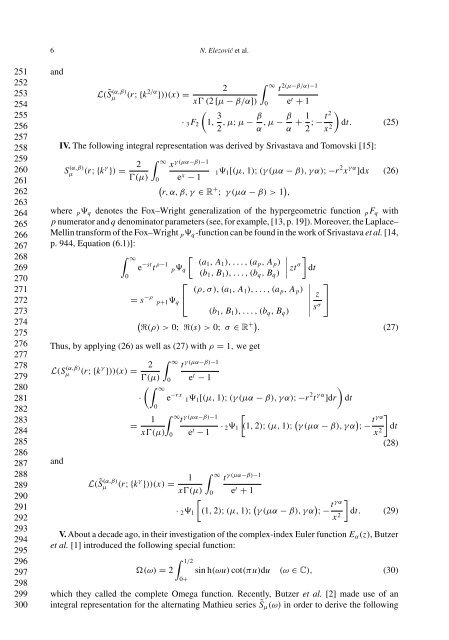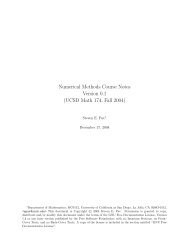Integral representations and integral transforms of some families of ...
Integral representations and integral transforms of some families of ...
Integral representations and integral transforms of some families of ...
Create successful ePaper yourself
Turn your PDF publications into a flip-book with our unique Google optimized e-Paper software.
6 N. Elezović et al.<br />
251<br />
252<br />
253<br />
254<br />
255<br />
256<br />
257<br />
258<br />
259<br />
260<br />
261<br />
262<br />
263<br />
264<br />
265<br />
266<br />
267<br />
268<br />
269<br />
270<br />
271<br />
272<br />
273<br />
274<br />
275<br />
276<br />
277<br />
278<br />
279<br />
280<br />
281<br />
282<br />
283<br />
284<br />
285<br />
286<br />
287<br />
288<br />
289<br />
290<br />
291<br />
292<br />
293<br />
294<br />
295<br />
296<br />
297<br />
298<br />
299<br />
300<br />
<strong>and</strong><br />
∫<br />
L( ˜S μ (α,β) (r;{k 2/α 2<br />
∞<br />
t 2(μ−β/α)−1<br />
}))(x) =<br />
xƔ (2 [μ − β/α]) 0 e t + 1<br />
(<br />
· 3F 2 1, 3 2 ,μ; μ − β α ,μ− β α + 1 2 )<br />
2 ;−t dt. (25)<br />
x 2<br />
IV. The following <strong>integral</strong> representation was derived by Srivastava <strong>and</strong> Tomovski [15]:<br />
S (α,β)<br />
μ (r;{k γ }) = 2<br />
Ɣ(μ)<br />
∫ ∞<br />
x γ (μα−β)−1<br />
0 e x − 1<br />
1 1 [(μ, 1); (γ (μα − β),γα);−r 2 x γα ]dx (26)<br />
(<br />
r, α, β, γ ∈ R + ; γ (μα − β) > 1 ) ,<br />
where p q denotes the Fox–Wright generalization <strong>of</strong> the hypergeometric function p F q with<br />
p numerator <strong>and</strong> q denominator parameters (see, for example, [13, p. 19]). Moreover, the Laplace–<br />
Mellin transform <strong>of</strong> the Fox–Wright p q -function can be found in the work <strong>of</strong> Srivastava et al. [14,<br />
p. 944, Equation (6.1)]:<br />
∫ ∞<br />
[ ]<br />
e −st t ρ−1 (a1 ,A 1 ),...,(a p ,A p )<br />
p q 0<br />
(b 1 ,B 1 ),...,(b q ,B q ) ∣ ztσ dt<br />
⎡<br />
⎤<br />
(ρ, σ ), (a 1 ,A 1 ),...,(a p ,A p )<br />
= s −ρ p+1 q<br />
⎣<br />
z<br />
⎦<br />
(b 1 ,B 1 ),...,(b q ,B q ) ∣ s σ<br />
(<br />
R(ρ) > 0; R(s) > 0; σ ∈ R<br />
+ ) . (27)<br />
Thus, by applying (26) as well as (27) with ρ = 1, we get<br />
L(S μ (α,β) (r;{k γ }))(x) = 2<br />
Ɣ(μ)<br />
(∫ ∞<br />
·<br />
0<br />
= 1<br />
xƔ(μ)<br />
∫ ∞<br />
t γ (μα−β)−1<br />
0 e t − 1<br />
e −rx 1 1 [(μ, 1); (γ (μα − β),γα);−r 2 t γα ]dr<br />
∫ ∞<br />
t γ (μα−β)−1<br />
0 e t − 1<br />
)<br />
dt<br />
[<br />
· 2 1 (1, 2); (μ, 1); ( γ (μα − β),γα ) ;− t γα ]<br />
dt<br />
x 2 (28)<br />
<strong>and</strong><br />
L( ˜S μ (α,β) (r;{k γ }))(x) = 1 ∫ ∞<br />
t γ (μα−β)−1<br />
xƔ(μ) 0 e t + 1<br />
[<br />
· 2 1 (1, 2); (μ, 1); ( γ (μα − β),γα ) ;− t γα ]<br />
dt. (29)<br />
x 2<br />
V. About a decade ago, in their investigation <strong>of</strong> the complex-index Euler function E α (z), Butzer<br />
et al. [1] introduced the following special function:<br />
(ω) = 2<br />
∫ 1/2<br />
0+<br />
sin h(ωu) cot(πu)du (ω ∈ C), (30)<br />
which they called the complete Omega function. Recently, Butzer et al. [2] made use <strong>of</strong> an<br />
<strong>integral</strong> representation for the alternating Mathieu series ˜S μ (ω) in order to derive the following














